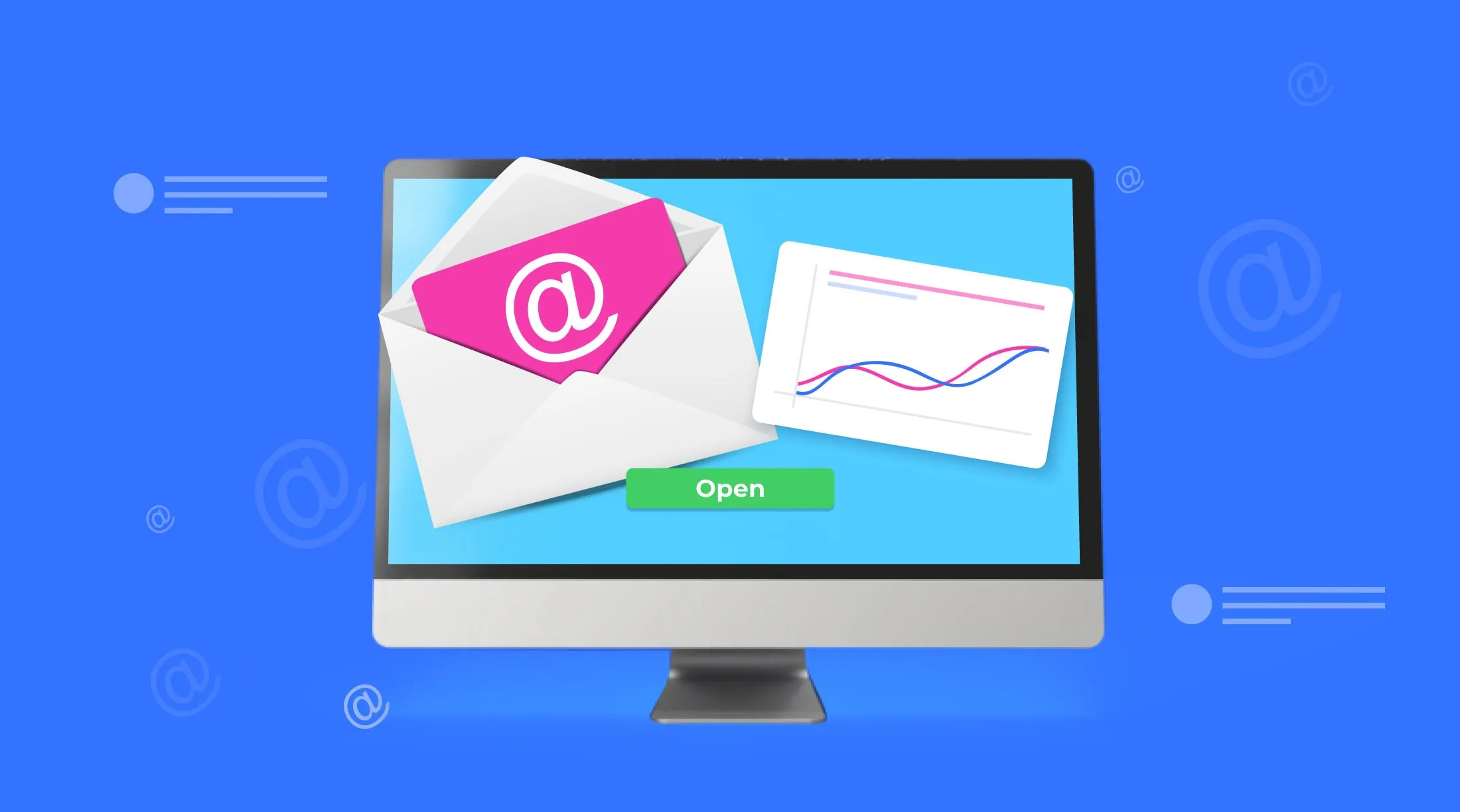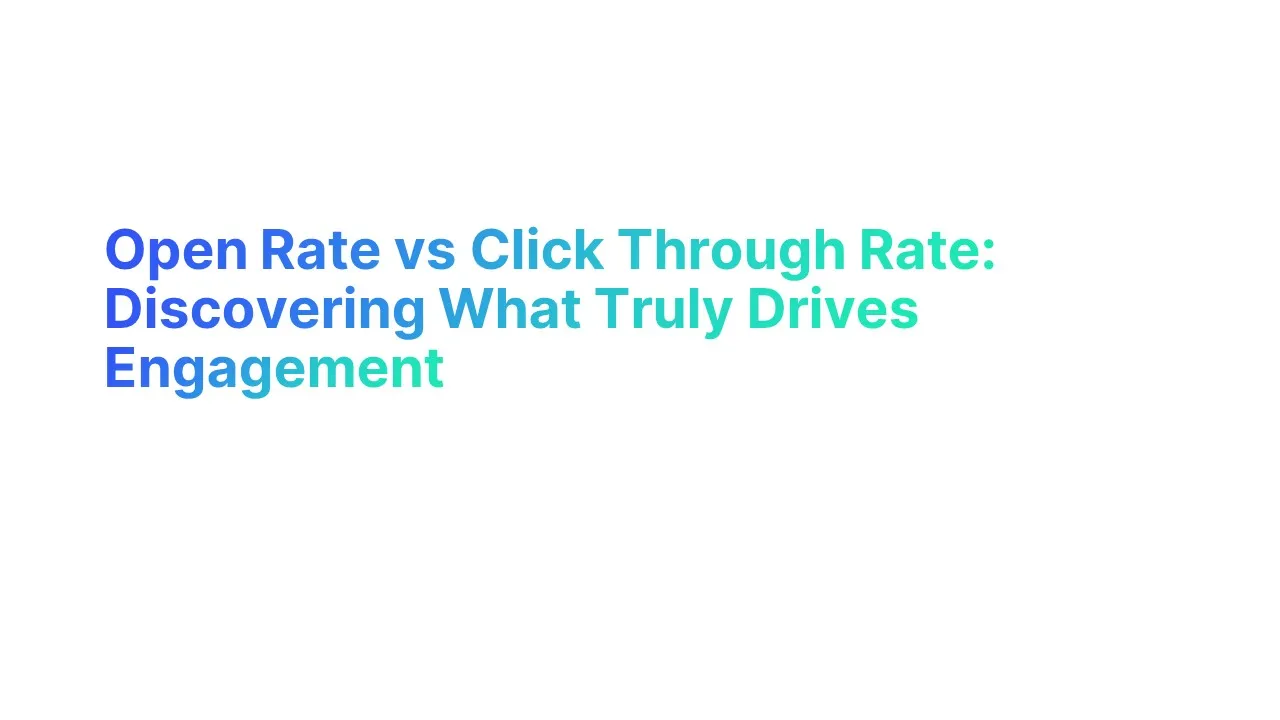Introduction to Email Marketing Metrics

What Are Open Rates and Click Through Rates
Open rates measure the percentage of recipients who open an email, indicating initial engagement.
Click through rates (CTR) track the percentage of recipients who click on one or more links within the email after opening it.
This metric is crucial for assessing deeper engagement beyond the initial open. For example, an industry average open rate might be around 20%, while an average click through rate could be closer to 2.5%, according to benchmarks from email marketing platforms.
What is Click to Open Rate?
The click to open rate (CTOR) compares the number of unique clicks to the number of unique opens. This rate shows how effective the email content was in driving action among those who opened the email.
A typical CTOR might range between 20-30%, suggesting that about a quarter of those who opened the email found the content compelling enough to click on a link.
Open Rate vs Click Through Rate vs Click to Open Rate
On What Things Does Open Rate and Click Through Rate is Dependent

The open rate and click-through rate (CTR) of email marketing campaigns are influenced by several factors. Here’s a detailed look at these dependencies:
Open Rate
1. Subject Line
- Relevance and Clarity: Clear and relevant subject lines attract more opens.
- Personalization: Using the recipient's name or personalized content can increase open rates.
- Length: Short and concise subject lines tend to perform better.
- Urgency and Curiosity: Creating a sense of urgency or curiosity can prompt recipients to open the email.
2. Sender Name
- Recognition and Trust: Emails from recognized and trusted senders are more likely to be opened.
- Consistency: Maintaining a consistent sender name builds trust over time.
3. Timing
- Day of the Week: Certain days, like Tuesdays and Thursdays, often yield higher open rates.
- Time of Day: Sending emails at times when recipients are most likely to check their inbox can improve open rates. Early morning or late afternoon are generally good times.
4. Preheader Text
- Informative and Enticing: A compelling preheader text that complements the subject line can boost open rates.
5. Email List Quality
- Segmentation: Targeting the right audience with segmented lists ensures higher relevance.
- Clean Lists: Regularly cleaning the email list to remove inactive or invalid emails helps maintain high open rates.
6. Frequency
- Consistency: Regular but not overwhelming frequency keeps the audience engaged.
- Preference: Matching the sending frequency with audience preferences prevents fatigue.
Click-Through Rate (CTR)
1. Content Quality
- Relevance: Content that is highly relevant to the audience’s interests will drive more clicks.
- Value: Offering value through content, such as exclusive offers, useful information, or valuable insights, encourages clicks.
2. Call-to-Action (CTA)
- Visibility: CTAs should be prominently placed and easily noticeable.
- Clarity: Clear and compelling CTAs with actionable language drive higher CTR.
- Design: Visually appealing buttons or links enhance clickability.
3. Design and Layout
- Responsive Design: Emails optimized for different devices and screen sizes perform better.
- Visual Appeal: A well-designed email with good use of images and whitespace can improve engagement.
- Readability: Easy-to-read fonts and a logical structure help convey the message effectively.
4. Personalization
- Customized Content: Personalized emails with tailored content and offers based on user behavior and preferences increase CTR.
- Dynamic Content: Using dynamic content blocks to show different content to different segments can enhance relevance and clicks.
5. Relevance and Segmentation
- Targeted Campaigns: Sending targeted campaigns to segmented lists ensures the content is relevant to the recipient.
- Behavioral Triggers: Using triggers based on user behavior (e.g., browsing history, past purchases) can increase CTR.
6. Follow-Up and Retargeting
- Reminder Emails: Sending follow-up emails or reminders can encourage clicks.
- Retargeting: Targeting users who have shown interest but haven’t clicked in previous emails can boost CTR.
Which is Better Drives More Engagement: Open Rate or Click Through Rate

When evaluating the effectiveness of email marketing campaigns, both Open Rate and Click-Through Rate (CTR) play crucial roles. Understanding which metric drives more engagement requires a nuanced analysis, as each provides different insights into the campaign's performance and audience behavior.
Open Rate
- Initial Engagement: A high Open Rate shows that the email has successfully captured the recipient's attention.
- Brand Awareness: Repeated opens can increase brand visibility and recall, even if no further action is taken.
- Opportunity for Interaction: Every open is a chance for the content to engage the recipient.
Click-Through Rate (CTR)
- Direct Interaction: A high CTR indicates that recipients are engaging with the content by clicking on links.
- Conversion Potential: Clicks can lead to further actions such as purchases, sign-ups, or other conversions.
- Content Relevance: Higher CTR suggests that the email content and CTAs are resonating with the audience.
Which Drives More Engagement?
While both metrics are important, CTR is generally considered a better indicator of engagement. Here's why:
Deeper Engagement:
- Action-Oriented: CTR measures the recipients' willingness to interact with the content, suggesting a deeper level of engagement.
- Conversions: Higher CTRs often correlate with higher conversion rates. For instance, Mailchimp reports that the average CTR across industries is about 2.62%, whereas a targeted, well-crafted email can achieve a CTR upwards of 10% .
Quality Over Quantity:
- Engaged Audience: A lower Open Rate but a higher CTR might indicate a more engaged and interested audience compared to a high Open Rate with low CTR.
- Efficient Campaigns: Campaigns with higher CTRs are often more efficient in achieving business goals such as sales or lead generation. For example, an email campaign with a 20% Open Rate and a 5% CTR is more valuable than one with a 40% Open Rate and a 1% CTR.
Supporting Data
To illustrate the importance of CTR, consider the following industry benchmarks:
- E-commerce: According to Campaign Monitor, the average Open Rate for e-commerce is 15.68%, while the CTR is 2.01% . Despite a lower Open Rate, the focus on driving clicks (and thus sales) makes CTR a more critical metric.
- Non-profits: Non-profits often see an average Open Rate of 25.96%, but a CTR of 2.66% . Here, the CTR is crucial for driving donations and volunteer sign-ups, demonstrating active engagement beyond just opening the email.
While a high Open Rate is a positive sign, it is the Click-Through Rate that truly measures engagement and drives business results. Focusing on improving CTR through compelling content, clear CTAs, and targeted segmentation will yield better overall outcomes for email marketing campaigns.
What are Good Open Rates and Click Through Rates
How to Calculate and Improve Open Rate

Open Rate is a key metric in email marketing efforts, indicating the percentage of recipients who open an email out of the total number of emails delivered. It’s a simple yet crucial measure of how well your subject lines and sender names attract your audience’s attention.
Formula to Calculate Open Rate:
Open Rate = (Number of Emails Opened / Number of Emails Delivered) × 100
For example, if you delivered 1,000 emails and 200 were opened, your Open Rate would be:
(200 / 1000) × 100 = 20%
Strategies to Improve Open Rate
Improving the Open Rate of your email marketing campaign involves a blend of crafting compelling content, strategic timing, and audience segmentation. Here’s how you can achieve better open rates:
1. Crafting Compelling Subject Lines
The subject line is the first thing a recipient sees, and it largely determines whether they open the email.
- Use Personalization: Including the recipient’s name can make the email feel more personalized. For example, "John, here’s your exclusive offer!" can grab attention.
- Create Curiosity: Phrasing your subject line to invoke curiosity can increase open rates. Questions or teasers work well, e.g., "Guess what’s back in stock?"
- Keep It Short and Sweet: Subject lines with 6-10 words tend to have higher open rates. Concise subject lines are easier to read quickly, especially on mobile devices.
2. Optimizing the Sender Name
The sender name should be recognizable and trustworthy.
- Use a Real Person’s Name: Emails from real people (e.g., “Jane from YourCompany”) often perform better than generic company names.
- Maintain Consistency: Using the same sender name across your campaigns builds recognition and trust over time.
3. Timing Your Emails
The time you send your emails can significantly impact open rates.
- Analyze Past Campaigns: Look at your previous email marketing efforts to identify when your audience is most active. Tools like Mailchimp or Campaign Monitor provide insights into optimal sending times.
- Test Different Times: Experiment with sending emails at various times and days to see what works best. Generally, Tuesday and Thursday mornings have shown higher engagement rates in many studies.
4. Segmenting Your Audience
Targeting specific segments of your audience ensures that your emails are relevant to the recipients.
- Use Demographics and Behavior: Segment based on factors like age, location, purchase history, and engagement levels. For example, sending tailored content to recent buyers can increase relevance and open rates.
- Dynamic Content: Incorporate dynamic content blocks that change based on the recipient’s profile, making the email more personalized and engaging.
5. Improving Preheader Text
The preheader text serves as an extension of your subject line.
- Complement the Subject Line: Ensure that your preheader text adds value and complements the subject line. For example, if the subject line is "Exclusive Offer Inside," the preheader could be "Save up to 50% on selected items."
- Keep It Short: Mobile devices often truncate longer preheader text, so keep it concise and to the point.
6. Ensuring Email Deliverability
Emails that land in the spam folder will never be opened.
- Authenticate Your Emails: Use SPF, DKIM, and DMARC authentication to improve your email’s credibility with ISPs.
- Maintain a Clean List: Regularly clean your email list to remove inactive subscribers. This helps maintain a healthy sender reputation.
7. Adapting to Mail Privacy Protection
With mail privacy protection features, tracking open rates can be challenging, but focusing on other metrics like click-to-open rates can provide deeper insights into engagement.
- Shift Focus: Instead of solely relying on open rates, consider metrics like click-to-open rates, which provide insights into how engaging your content is once opened.
- Encourage Clicks: Design your emails to drive engagement through clickable content, thereby enhancing both click rate and conversion rate.
How to Calculate and Improve Your Click Through Rate

CTR is a fundamental metric in email marketing, indicating the percentage of recipients who clicked on one or more links in your email out of the total number of emails delivered. It’s a direct measure of your email content’s effectiveness and the interest level of your audience.
Formula to Calculate CTR:
CTR=( Number of Clicks / Number of Emails Delivered ) × 100
For example, if you delivered 1,000 emails and received 50 clicks, your CTR would be:
(50 / 1000) × 100 = 5
Strategies to Improve Click-Through Rate (CTR)
Improving CTR requires a strategic approach to content creation, audience targeting, and user engagement. Here’s how you can enhance your CTR:
1. Creating Engaging Content
The content of your email plays a crucial role in encouraging clicks.
- Relevance and Value: Ensure your content is relevant and valuable to the recipient. Personalized offers, relevant articles, or useful tips can increase engagement.
- Clear and Compelling CTAs: Use clear, compelling, and actionable call-to-action (CTA) buttons. For example, “Shop Now,” “Learn More,” or “Get Started” are effective CTAs.
- Visual Appeal: Incorporate visuals such as images, videos, and infographics to make the email more engaging and interactive.
2. Personalization and Segmentation
Tailoring your emails to the preferences and behaviors of your recipients can significantly improve CTR.
- Behavior-Based Segmentation: Segment your audience based on their behavior, such as past purchases or browsing history. For example, sending product recommendations to recent buyers.
- Dynamic Content: Use dynamic content to personalize emails for each recipient. This can be as simple as including the recipient’s name or as complex as changing the content based on their interests.
3. Optimizing Email Design
A well-designed email can guide the recipient to take action.
- Responsive Design: Ensure your emails are mobile-friendly. Over 50% of emails are opened on mobile devices, and a poor mobile experience can hurt your CTR.
- Layout and Structure: Use a clean and simple layout with a clear hierarchy. Place your primary CTA above the fold to make it immediately visible.
- Whitespace and Readability: Use whitespace effectively to make the email easy to read and navigate.
4. A/B Testing
Regularly testing different elements of your emails can help you understand what works best.
- Subject Lines and Preheaders: Test different subject lines and preheader texts to see which ones drive more opens and clicks.
- Content and CTAs: Experiment with different content formats and CTA designs. For example, try different wording, colors, and placements of your CTAs.
- Sending Times: Test different sending times and days to identify when your audience is most likely to engage.
5. Enhancing Deliverability
Ensuring your emails reach the inbox is a critical step in improving CTR.
- List Hygiene: Regularly clean your email list to remove inactive subscribers. This improves deliverability and sender reputation.
- Authentication: Use email authentication methods like SPF, DKIM, and DMARC to reduce the chances of your emails being marked as spam.
Concluding Thoughts
In email marketing, both Open Rate and Click-Through Rate (CTR) are crucial. While Open Rate shows initial interest, CTR measures real engagement.
For future campaigns, focus on creating compelling content, personalizing messages, and optimizing email design to improve both metrics. This approach will enhance your email marketing efforts, driving higher engagement and better conversion rates.
By understanding and optimizing these metrics, you can make your digital marketing campaigns more effective and impactful for same user.







.jpg)

